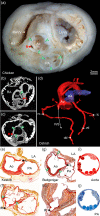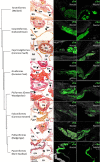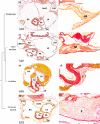Comparative analysis of avian hearts provides little evidence for variation among species with acquired endothermy
- PMID: 30667083
- PMCID: PMC6590421
- DOI: 10.1002/jmor.20952
Comparative analysis of avian hearts provides little evidence for variation among species with acquired endothermy
Abstract
Mammals and birds acquired high performance hearts and endothermy during their independent evolution from amniotes with many sauropsid features. A literature review shows that the variation in atrial morphology is greater in mammals than in ectothermic sauropsids. We therefore hypothesized that the transition from ectothermy to endothermy was associated with greater variation in cardiac structure. We tested the hypothesis in 14 orders of birds by assessing the variation in 15 cardiac structures by macroscopic inspection and histology, with an emphasis on the atria as they have multiple features that lend themselves to quantification. We found bird hearts to have multiple features in common with ectothermic sauropsids (synapomorphies), such as the presence of three sinus horns. Convergent features were shared with crocodylians and mammals, such as the cranial offset of the left atrioventricular junction. Other convergent features, like the compact organization of the atrial walls, were shared with mammals only. Pacemaker myocardium, identified by Isl1 expression, was anatomically node-like (Mallard), thickened (Chicken), or indistinct (Lesser redpoll, Jackdaw). Some features were distinctly avian, (autapomorphies) including the presence of a left atrial antechamber and the ventral merger of the left and right atrial auricles, which was found in some species of parrots and passerines. Most features, however, exhibited little variation. For instance, there were always three systemic veins and two pulmonary veins, whereas among mammals there are 2-3 and 1-7, respectively. Our findings suggest that the transition to high cardiac performance does not necessarily lead to a greater variation in cardiac structure.
Keywords: anatomy; bird; evolution; heart.
© 2019 The Authors. Journal of Morphology published by Wiley Periodicals, Inc.
Figures








Similar articles
-
Whole-body endothermy: ancient, homologous and widespread among the ancestors of mammals, birds and crocodylians.Biol Rev Camb Philos Soc. 2022 Apr;97(2):766-801. doi: 10.1111/brv.12822. Epub 2021 Dec 10. Biol Rev Camb Philos Soc. 2022. PMID: 34894040 Free PMC article.
-
A phenology of the evolution of endothermy in birds and mammals.Biol Rev Camb Philos Soc. 2017 May;92(2):1213-1240. doi: 10.1111/brv.12280. Epub 2016 May 7. Biol Rev Camb Philos Soc. 2017. PMID: 27154039 Review.
-
The coronary circulation of the heart of the ostrich (Struthio camelus).J Anat. 1984 May;138 ( Pt 3)(Pt 3):385-97. J Anat. 1984. PMID: 6735902 Free PMC article.
-
A molecular model for the evolution of endothermy in the theropod-bird lineage.J Exp Zool. 2001 Dec 15;291(4):317-38. doi: 10.1002/jez.1132. J Exp Zool. 2001. PMID: 11754012
-
The evolution of endothermy and its diversity in mammals and birds.Physiol Biochem Zool. 2004 Nov-Dec;77(6):982-97. doi: 10.1086/425188. Physiol Biochem Zool. 2004. PMID: 15674771 Review.
Cited by
-
Morpho-functional characterization of the heart of Gallus gallus domesticus with special reference to the right muscular atrioventricular valve.J Anat. 2019 Oct;235(4):794-802. doi: 10.1111/joa.13020. Epub 2019 May 30. J Anat. 2019. PMID: 31148176 Free PMC article.
-
High heart rate associated early repolarization causes J-waves in both zebra finch and mouse.Physiol Rep. 2021 Mar;9(5):e14775. doi: 10.14814/phy2.14775. Physiol Rep. 2021. PMID: 33709567 Free PMC article.
-
Anatomy of the heart with the highest heart rate.J Anat. 2022 Jul;241(1):173-190. doi: 10.1111/joa.13640. Epub 2022 Feb 6. J Anat. 2022. PMID: 35128670 Free PMC article.
-
Reptiles as a Model System to Study Heart Development.Cold Spring Harb Perspect Biol. 2020 May 1;12(5):a037226. doi: 10.1101/cshperspect.a037226. Cold Spring Harb Perspect Biol. 2020. PMID: 31712265 Free PMC article. Review.
-
Smooth Muscle in Cardiac Chambers is Common in Turtles and Extensive in the Emydid Turtle, Trachemys scripta.Anat Rec (Hoboken). 2020 May;303(5):1327-1336. doi: 10.1002/ar.24257. Epub 2019 Oct 10. Anat Rec (Hoboken). 2020. PMID: 31509333 Free PMC article.
References
-
- Adams, W. E. (1937). A contribution to the anatomy of the avian heart as seen in the kiwi (Apteryx australis) and the yellow‐crested penguin (Megadyptes antipodum). Proceedings of the Zoological Society of London, 107(3), 417–441.
-
- Alsafy, M. A. M. , El‐Gendy, S. A. , Enany, S. , & Amine, M. (2009). Anatomical studies on the atrioventricular valves of the ostrich heart (Struthio camelus). Journal of Veterinary Anatomy, 2(1), 67–83.
-
- Barske, J. , Eghbali, M. , Kosarussavadi, S. , Choi, E. , & Schlinger, B. A. (2019). The heart of an acrobatic bird. Comparative Biochemistry and Physiology Part A: Molecular & Integrative Physiology, 228, 9–17. - PubMed
-
- Bartyzel, B. J. (2009a). Morphology of the pulmonary valve (valva trunci pulmonali) in chosen species of domestic and wild birds using imaging methods. Bulletin of the Veterinary Institute in Pulawy, 53, 303–308.
-
- Bartyzel, B. J. (2009b). The aortic valve and other heart structures of selected species of sea birds in a morphological and imaging scope. Electronic Journal of Polish Agricultural Universities, 12, 4.
Publication types
MeSH terms
LinkOut - more resources
Full Text Sources

